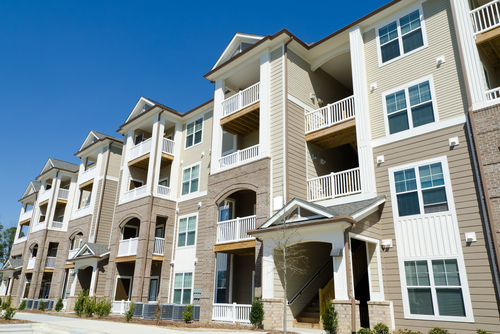Apartment buildings, long considered a real-estate haven, are emerging as the next major trouble spot in the beleaguered commercial-property world.
Investors bid up the prices of multifamily buildings for years, attracted by steadily rising rents and the prospect of outsize returns. Many took on too much debt, expecting they could raise rents fast enough to pay it down.
Unlike office buildings and malls, which have been hit hard by remote work and e-commerce, rental apartments have low vacancy rates. The apartment sector’s main problem isn’t a lack of demand—rents have soared since 2020—it is interest rates.
The sudden surge in debt costs last year now threatens to wipe out many multifamily owners across the country. Apartment-building values fell 14% for the year ended in June after rising 25% the previous year, according to data company CoStar. That drop is roughly the same as the fall in office values.
Apartment landlords face a “hydrogen-bomb scenario,” said Peter Sotoloff, a veteran real-estate finance executive and founding member of Blackstone’s property debt business.
Outstanding multifamily mortgages more than doubled over the past decade to about $2 trillion, according to the Mortgage Bankers Association. That is nearly twice the amount of office debt, according to Trepp. The data provider adds that $980.7 billion in multifamily debt is set to come due between 2023 and 2027.
Mortgage delinquencies in the multifamily category are low but increasing. Borrowing costs have doubled, rent growth is slowing and building expenses are rising. Data provider Trepp earlier this year identified one type of rental-apartment debt as accounting for a large share of the commercial mortgages at risk of default.
Apartment landlords face a “hydrogen-bomb scenario,” said Peter Sotoloff, a veteran real-estate finance executive and founding member of Blackstone’s property debt business.
Outstanding multifamily mortgages more than doubled over the past decade to about $2 trillion, according to the Mortgage Bankers Association. That is nearly twice the amount of office debt, according to Trepp. The data provider adds that $980.7 billion in multifamily debt is set to come due between 2023 and 2027.
To many investors, these factors justified paying high prices. Apartment-building owners often borrowed more than 80% of the building value from bond markets. Most apartment loans are fixed-rate, long-term mortgages. During the pandemic, however, investors took out more shorter-term, floating-rate loans.
Many of these investors raised rents aggressively, betting that they could sell the buildings or refinance their debt at much higher valuations once their buildings generated higher rental income.
But few anticipated that interest rates could rise so quickly, pushing down building values and forcing landlords to refinance at much higher rates. Regional banks, a crucial source of funding, are lending far less today, making it harder to refinance mortgages. Rent growth has slowed sharply in many U.S. cities, while inflation and growing insurance premiums have raised the cost of running buildings.
A new crop of private real-estate firms, funded mostly by floating-rate debt and small-investor cash, have become bigger competitors in the multifamily market. Some paid higher prices based on rosy expectations of steep rent increases for years to come. Now, they are having trouble making the numbers work.
Los Angeles-based Tides Equities has acquired more than $6.5 billion in rental property since 2016, mostly lower- and middle-income apartment buildings in Southwestern cities. In 2021, at a property in a Dallas suburb, the company expected to push up rents 44% over the course of three years, ratings-agency reports show.
In June, Tides told investors the strategy wasn’t going as planned. Renters were “becoming too tight on cash,” the company said in a letter. Some properties were no longer earning enough money to cover debt payments, and investors would likely need to put in more money to save buildings from default, the letter said.
In an interview, Tides’s co-founders Sean Kia and Ryan Andrade said they were working with lenders on ways to avoid default at properties that faced difficulties.
Houston-based Nitya Capital, owner of about $3 billion of multifamily buildings, notified investors in March that it was slashing profit expectations because of steeper interest rates.
“We are essentially paying the higher mortgage costs instead of making cash distributions,” Nitya Chief Executive Swapnil Agarwal wrote in an investor letter.
Apartment landlords still have reasons for optimism. Fannie Mae and Freddie Mac offer a reliable source of government-backed lending even as banks retreat. Most analysts expect housing shortages, and high rents, to persist. If interest rates come down, property prices could bounce back quickly. Multifamily owners with fixed-rate mortgages are better positioned to ride out any near-term turbulence.
Still, other threats are mounting. The unusually high number of new apartment buildings opening this year and next, especially on the higher end of the rental market, poses a supply concern.
Further, apartment-building values are more vulnerable to higher rates than their commercial counterparts because they are closely tied to the price of 10-year Treasury notes, which plunged as rates rose, said Chad Littell, CoStar’s national director of capital-markets analytics.
Even some veteran real-estate investors that weathered past storms look vulnerable. Veritas Investments, one of San Francisco’s largest landlords, and partners defaulted on debt backing 95 rental buildings during the past year. It stands to lose more than one-third of its San Francisco portfolio as a result.
“The multifamily real-estate sector is facing many of the same financial challenges as have been reported on for other asset classes including office, retail and hotel-hospitality” the company said earlier this year.













